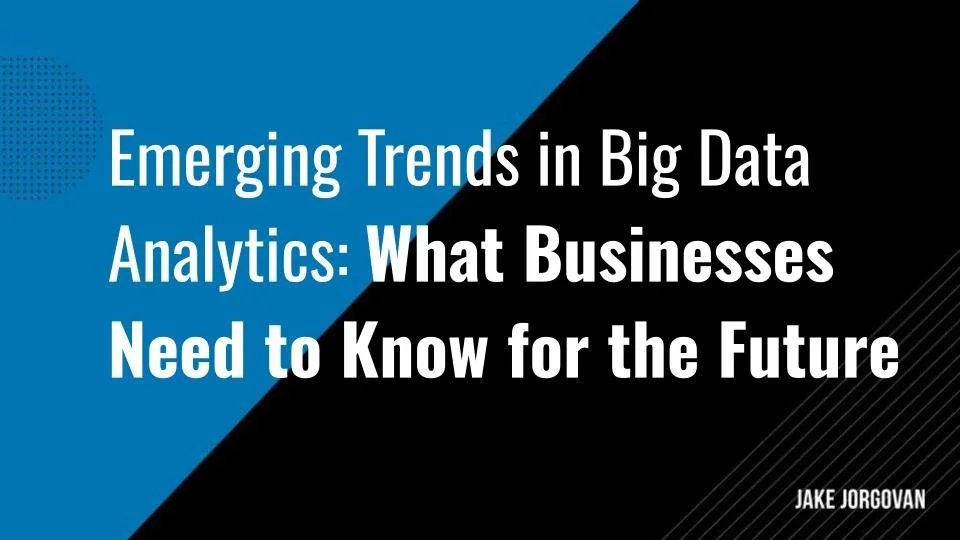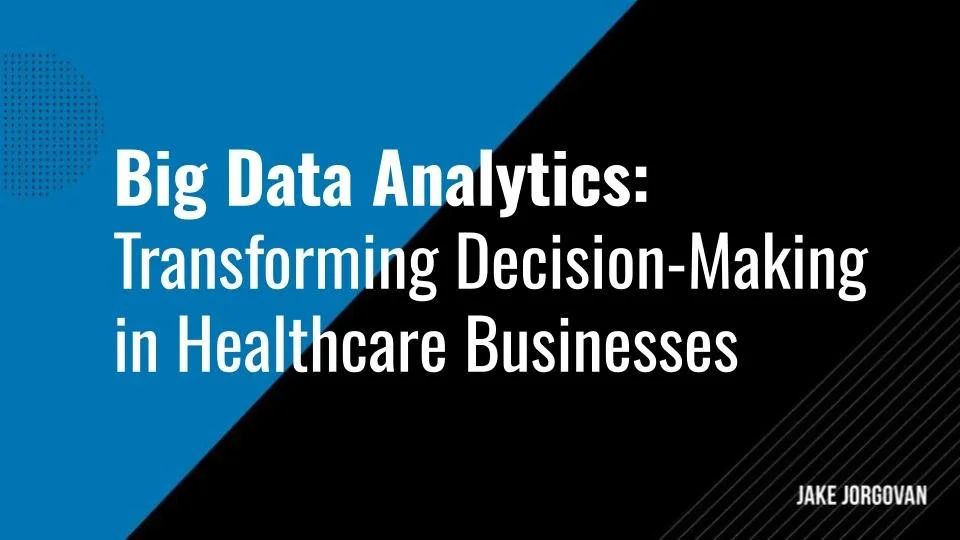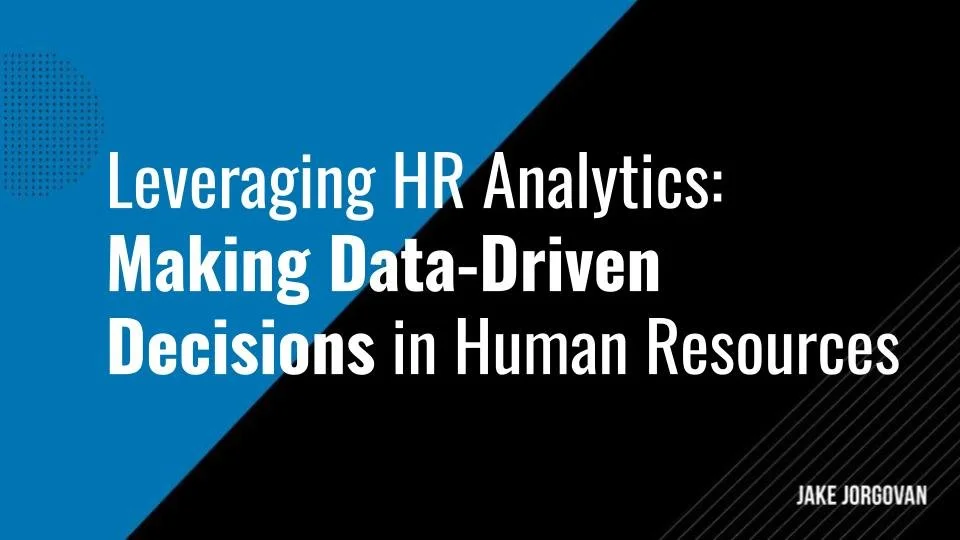Emerging Trends in Big Data Analytics: What Businesses Need to Know for the Future
Big data analytics is evolving fast. And these rapid technological advancements threaten to leave some businesses lagging.
The global big data analytics market is projected to reach $105.08 billion by 2027, growing at a compound annual growth rate (CAGR) of 12.3% from 2019 to 2027.
Though this pace of change is difficult to keep up with, you’re not alone on this journey. As a business owner, you’re in the right place to tackle these challenges.
This article will cover:
The evolution of big data analytics
6 key emerging trends in big data analytics
How businesses can plan for and adapt to these trends
Keep reading to equip your business with the necessary knowledge to embrace the future of big data analytics.
The Evolution of Big Data Analytics
Over the past decade, you've witnessed big data analytics transform drastically. Initially, the focus was primarily on volume. Data surged, and companies collected vast amounts. It was all about storing and managing this data.
However, as technology progressed, the emphasis shifted. Not just volume but velocity and variety became crucial. Insights needed to be faster, and data sources diversified. Just look at the wide range of applications for data analytics today:
We’ve dived deeply into these trends. What we found is a shift toward real-time analytics. You see, specialized business owners like yourself now require immediate insights to stay competitive. In fact, you can become 10X more productive using these insights. This is not just about handling data; it's about leveraging it strategically. Machine learning algorithms have evolved. They process data in real-time, learn from it, and adapt.
This brings us to an important point from our extensive research: Prioritize adaptability in your data strategies. The landscape will continue to evolve. Tools that adapt to new data types and learning models will provide the most value. This isn’t just about keeping up. It’s about staying ahead.
As we move forward, the integration of AI with big data analytics is becoming seamless. Predictive analytics are becoming more accurate and nuanced. They’re not just predicting trends. They're prescribing actions. Your next move is suggested by algorithms that understand your business almost as well as you do.
And remember, it’s not only about technology. It’s about how you use this technology to make informed decisions, pivot, and innovate. This is where you gain your edge. As big data continues to evolve, so should your strategies. Keep adapting, and you'll set the pace in your industry.
6 Key Emerging Trends in Big Data Analytics
So, let’s see the biggest trends in big data analytics – no pun intended.
1. Growing Emphasis on Real-Time Data Processing
Staying agile is crucial for your business as markets accelerate and data floods in. Real-time data processing offers a competitive edge, ensuring your decisions are timely and informed.
Here are the key reasons why:
Accelerated decision-making: Immediate actionable insights mean you can respond to market changes swiftly, outpacing competitors who lag.
Enhanced customer experiences: Real-time analytics enable adjustments to strategies based on customer interactions, offering personalized experiences instantly.
Transformed risk management: You can detect anomalies as they occur to prevent fraud and mitigate risks before they escalate.
Streamlined operational efficiency: The biggest advantage here is you can monitor systems in real-time, optimize resources, and reduce downtime to achieve efficiency and effectiveness. Manufacturers using real-time data to monitor equipment have achieved a 25% decrease in downtime.
Fostering innovation: Analyze trends as they develop and innovate based on current data, not historical guesses.
Support for regulatory compliance: Stay ahead of regulations that require immediate data reporting to avoid penalties and ensure compliance.
Real-time analytics is growing fast; the market size was $27.6 billion in 2024, but is expected to reach $147.5 billion in 2031. Don’t get left behind!
2. Integration of AI and Machine Learning for Predictive Analytics
Integrating artificial intelligence and machine learning for predictive analytics furnishes your business with foresight, not just insights. The graphic below shows some common use cases here.
This technology predicts trends and behaviors, which enables you to make proactive decisions that keep your company ahead in a competitive market.
This trend is important for several reasons. First, AI models analyze vast datasets with complex variables. Accuracy increases, so forecasts become reliable. Decisions are data-driven, not guesswork. In fact, companies using AI-driven predictive analytics improve forecasting accuracy by up to 85%, leading to better decision-making and resource allocation.
Also, machine learning algorithms adjust to new data as it arrives and insights evolve. You can finally react in real time. As a result, you can stay ahead in pace and anticipation. AI automates the grunt work of data analysis and efficiency soars. This means human analysts focus on strategy, not just number crunching.
Another important factor is that AI identifies patterns in customer behavior, so personalization deepens. That’s how you can engage actual individuals, not just demographics.
Predictive maintenance saves money too, by identifying potential breakdowns before they occur. Downtime decreases, and costs saved on repairs can be substantial. In manufacturing, predictive maintenance powered by AI reduces equipment downtime by up to 50% and lowers maintenance costs by 10-40%.
Making use of predictive analytics positions you ahead of market trends. Basically, your competitors follow, and you lead.
This case study shows how companies can use predictive maintenance, driven by machine learning, to reduce downtime and save on maintanence costs, all while running more efficient manufacturing operations.
3. Expansion of Edge Computing to Handle Data Closer to the Source
Edge computing revolutionizes how data is handled across industries, which brings computation closer to data sources. This shift improves response times and enhances overall system performance, which is crucial for your dynamic business environment. The graphic below shows how the edge computing market is skyrocketing in size:
Here’s what edge computing brings to the table:
Reduced latency: Data processed closer to where it’s collected significantly reduces delay. Instantaneous valuable insights become the norm, not the exception. And these insights help you respond faster to real-world events. Ultimately, that’s what sets you apart.
Decreased bandwidth costs: By handling data locally, you minimize the data that travels across the network. Costs drop, and efficiency climbs. This approach can reduce traffic between edge and cloud servers by over 90%, leading to lower costs and increased efficiency.
Enhanced data security: Processing data locally limits exposure to vulnerabilities during transmission. Secure data means a secure business.
Improved reliability: Dependency on central data centers diminishes. As a result, edge computing provides resilience. Networks may falter, but your local processing does not.
Scalability: As data volume grows, so does the strain on infrastructure. Edge computing disperses this load. Even better, it scales with you.
Real-time analytics: For industries requiring real-time decision-making, like manufacturing or healthcare, edge computing is not just useful; it's critical.
4. Increased Use of Natural Language Processing (NLP) for Data Interaction
The incorporation of natural language processing into big data analytics tools transforms interactions between you and your data. NLP enables more intuitive, human-like communication, allowing you to query and receive insights as naturally as speaking. This is a game-changer. By 2024, the NLP market is projected to reach $158.04 billion, which highlights its critical role in analyzing vast amounts of unstructured data.
This matters for a few reasons. For example, NLP bridges the gap between data science and non-technical users. You speak, it responds—simplicity at its finest. It also improves user interaction since interfaces that understand human language make interactions intuitive. Forget code; talk to your data.
NLP excels in extracting value from unstructured text. Emails, social media, customer reviews—it deciphers them all. And it also automates responses and generates reports. Efficiency soars as human error declines.
Another benefit is data-driven decision. NLP analyzes text on the fly, from customer feedback to market trends. Decisions are faster and grounded in current data. And it’s easier to understand customer emotions and market sentiments in real-time so you can adapt your strategies and enhance engagement.
Insider tip:
Invest in customizing your NLP tools to understand your industry's specific jargon and nuances. This customization allows for far more precise interpretations and relevant responses, turning generic tools into specialized assets for your business. This approach has significant benefits in enhancing decision-making and customer interactions. Tailor your tools; transform your analytics.
5. Adoption of Cloud-Native Technologies for Scalability and Flexibility
Adopting cloud-native technologies is more than a trend; it's a strategic move for scalability and flexibility in your operations. Look at the graphic below for an overview of the state of the cloud-native market:
These technologies adapt fluidly to your business needs, which supports growth without the traditional infrastructural constraints.
Here’s why this shift is critical:
Seamless scalability: Cloud-native frameworks scale resources dynamically. Demand spikes? No problem. Scale up effortlessly, scale down when it subsides.
Operational flexibility: Deploy across multiple environments. Cloud-native technologies allow you to adapt quickly because they support agile operations. Basically, you finally get software that makes change easy, not daunting. By 2025, more than 95% of new digital workloads are expected to be deployed on cloud-native platforms, up from just 30% in 2021.
Cost efficiency: Pay for what you use, nothing more. Adopting cloud-native technologies allows you to reduce overheads and optimize spending.
Faster Time to market: This solution leads to accelerated development cycles. That’s because cloud-native tools streamline updates so that innovations reach the market quickly.
Enhanced collaboration: Teams collaborate in real-time, irrespective of location. Barriers dissolve, and productivity soars.
Resilience and reliability: Built-in redundancy and fault tolerance ensure services remain online. Downtime diminishes, which is always an advantage.
6. Ethical and Privacy Focused Data Governance Initiatives
In an era where data breaches undermine customer trust, ethical and privacy-focused data governance is essential. There are lots of things to consider here, as shown in the image below:
Such initiatives protect your company legally and enhance your reputation in the eyes of your clients.
Here’s why they’re essential:
Trust building: Transparent data usage builds trust. And customers share more when they trust. More importantly, this trust translates into deeper data pools.
Regulatory compliance: Staying ahead of legal frameworks avoids fines. It’s not just about compliance or dodging financial backlash, either. It’s about demonstrating leadership in data ethics.
Enhanced brand reputation: Ethical practices distinguish you from competitors, and your reputation grows. As a result, more customers and partners choose your brand for integrity.
Risk mitigation: Privacy-focused governance reduces breaches. Secure data equals a secure business. It’s straightforward if you think about it: fewer breaches mean fewer crises. The average cost of a data breach according to IBM reached an all-time high in 2024 of $4.88 million, a 10% increase from 2023.
Long-term viability: Ethical guidelines ensure sustainable data practices and allow you to future-proof your operations. Regulations may always tighten, so it’s best to be ready.
Innovation enablement: When boundaries are clear, innovation thrives within them. Create new data-driven products safely, without ethical concerns.
Insider tip:
Engage in regular audits of your data governance policies. It's not just about setting policies but actively ensuring they're followed and remain effective as technologies and regulations evolve. We've found that continuous auditing keeps compliance on track and boosts internal and external confidence in your data handling. Audit regularly so you can stay ahead confidently.
Planning for the Future and Adapting to Emerging Trends
Business adaptation in response to emerging big data analytics trends — like those shown below — is necessary and imperative for growth.
Invest in technologies that align with these new directions. This ensures your infrastructure can support the new demands. Do not simply buy technology; understand it. Know why it benefits your operation.
Training is critical. Staff must understand new systems. This isn't optional. Invest in continuous education. It equips your team to handle and maximize new technologies. Companies with comprehensive employee training programs experience 218% higher income per employee than those without formalized training.
Review your current technology stack. Is it flexible? Can it integrate new solutions quickly? If not, consider upgrades or replacements. Compatibility issues can cripple transitions. Smooth integration facilitates smoother operations. Also, ensure your IT team is involved because their expertise will guide these transitions better.
Assess your data handling capabilities. Are they robust enough for new data volumes? Your systems should handle increased loads without compromise. If they falter, address this gap. Scalability is your friend here. So, plan for growth before it happens.
Security measures need reassessment. New technologies introduce new vulnerabilities. Strengthen your defenses and protect your assets. Your clients rely on your discretion and integrity, so do not let them down.
Financial planning must not be overlooked. Budget for new investments. Consider operational costs and potential ROI. Wise spending decisions support sustained growth and prevent financial strain.
Stay informed. The business landscape evolves rapidly. Keep abreast of changes, attend industry conferences, and subscribe to relevant publications. Knowledge empowers because it enables proactive rather than reactive strategies.
This proactive approach positions your business at the forefront of industry changes. More importantly, it shows foresight and builds confidence among your clients and your team.
Embrace Emerging Trends with Confidence
This article has outlined key emerging trends in big data analytics, from real-time processing to the integration of AI. Each plays a critical role in shaping the future of business operations.
Understanding these trends is vital. They represent the future of technology and the evolving landscape of business decision-making. Staying informed ensures your business remains competitive and responsive.
Consider this an opportunity. Reflect on how these key trends can be adapted to your strategic goals. You can lead your industry in innovation and efficiency with the right approach.
Keep this information in mind as you plan your next steps. The future is promising, and with the right knowledge, you're well-equipped to meet it head-on.
FAQ — What You Need to Know About Big Data Trends
What are some big data trends in 2025?
In 2025, key big data trends include increased adoption of AI-driven analytics, real-time data processing through edge computing, and stronger data privacy regulations.
What is the future of big data?
The future of big data revolves around automation, AI integration, and decentralized storage solutions, all of which allow businesses to process vast amounts of information faster while maintaining compliance with stricter privacy laws.
Is big data an evolving term?
Yes, big data is an evolving term as advancements in technology continuously redefine how data is collected, stored, and analyzed.
What is the difference between big data and predictive analytics?
Big data refers to the vast, complex datasets generated daily, while predictive analytics uses statistical models and machine learning to analyze that data and forecast future trends or outcomes.














